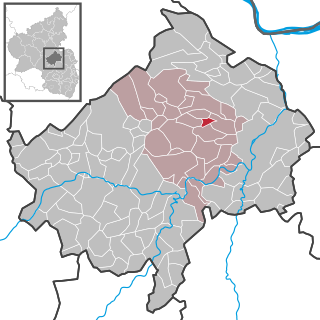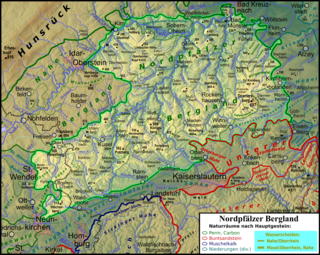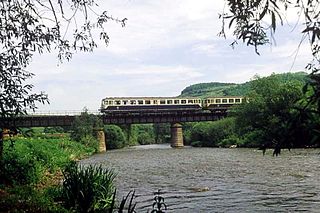
The Naheland is the landscape on either side of the river Nahe in the German state of Rhineland-Palatinate. [1]

The Naheland is the landscape on either side of the river Nahe in the German state of Rhineland-Palatinate. [1]
The southern foothills of the Hunsrück and the northern North Palatine Uplands on either side of the Nahe are both described as the "Naheland". The Naheland extends for about 80 km from west to east from the source of the river in the Saarland to its mouth on the Rhine in the town of Bingen. Whilst the narrow strip of land in the west is covered by woods and agricultural land, vineyards of the Nahe wine region dominate the wider eastern section. [2]
The Naheland lies in the two counties of Birkenfeld and Bad Kreuznach.
Naheland has a rich musical culture consisting of many choirs, wind orchestras, big bands and specialised music groups. Many professional musicians come from this part of the world or work here. Naheland has an amazing history with plenty of historical and artistic landmarks. [3]
The main transport axes of the region run parallel to the Nahe. The B 41 federal road and the non-electrified rail service on the Nahe Valley Railway are of statewide significance.
The term "Naheland" (formerly: "Nahegau") is now increasingly used in the marketing of the region for tourism purposes; Naheland's tourist office being in Kirn. For ramblers there are nine circular walks, the so-called "vital tours".
Bad Kreuznach is a district in Rhineland-Palatinate, Germany. It is bounded by the districts of Rhein-Hunsrück, Mainz-Bingen, Alzey-Worms, Donnersbergkreis, Kusel and Birkenfeld.

The Nahe is a river in Rhineland-Palatinate and Saarland, Germany, a left tributary to the Rhine. It has also given name to the wine region Nahe situated around it.

Rüdesheim an der Nahe, or simply Rüdesheim, is an Ortsgemeinde – a municipality belonging to a Verbandsgemeinde, a kind of collective municipality – in the Bad Kreuznach district in Rhineland-Palatinate, Germany. It belongs to the Verbandsgemeinde of Rüdesheim, and is also its seat. Rüdesheim customarily takes the tag “an der Nahe” to distinguish itself from nearby Rüdesheim am Rhein. Rüdesheim is laid out in state planning as a lower centre. Rüdesheim is a winegrowing village.

Abtweiler is an Ortsgemeinde – a municipality belonging to a Verbandsgemeinde, a kind of collective municipality – in the Bad Kreuznach district in Rhineland-Palatinate, Germany. It belongs to the Verbandsgemeinde of Meisenheim, whose seat is in the like-named town.

Burgsponheim is an Ortsgemeinde – a municipality belonging to a Verbandsgemeinde, a kind of collective municipality – in the Bad Kreuznach district in Rhineland-Palatinate, Germany. It belongs to the Verbandsgemeinde of Rüdesheim, whose seat is in the municipality of Rüdesheim an der Nahe. Burgsponheim is a winegrowing centre.

Guldental is an Ortsgemeinde – a municipality belonging to a Verbandsgemeinde, a kind of collective municipality – in the Bad Kreuznach district in Rhineland-Palatinate, Germany. It belongs to the Verbandsgemeinde Langenlonsheim-Stromberg, whose seat is in Langenlonsheim. With a population of some 2,900 inhabitants, Guldental is the biggest rural winegrowing community on the Nahe.

Hergenfeld is an Ortsgemeinde – a municipality belonging to a Verbandsgemeinde, a kind of collective municipality – in the Bad Kreuznach district in Rhineland-Palatinate, Germany. It belongs to the Verbandsgemeinde of Rüdesheim, whose seat is in the municipality of Rüdesheim an der Nahe. Hergenfeld is a winegrowing village.

Hochstetten-Dhaun is an Ortsgemeinde – a municipality belonging to a Verbandsgemeinde, a kind of collective municipality – in the Bad Kreuznach district in Rhineland-Palatinate, Germany. It belongs to the Verbandsgemeinde Kirner Land, whose seat is in the town of Kirn. Hochstetten-Dhaun is a state-recognized recreational community.

Oberhausen an der Nahe is an Ortsgemeinde – a municipality belonging to a Verbandsgemeinde, a kind of collective municipality – in the Bad Kreuznach district in Rhineland-Palatinate, Germany. It belongs to the Verbandsgemeinde of Rüdesheim, whose seat is in the like-named town. Oberhausen is a winegrowing village. Oberhausen an der Nahe is one of two municipalities in the district with the name Oberhausen. The other is Oberhausen bei Kirn.

Oberstreit is an Ortsgemeinde – a municipality belonging to a Verbandsgemeinde, a kind of collective municipality – in the Bad Kreuznach district in Rhineland-Palatinate, Germany. It belongs to the Verbandsgemeinde of Rüdesheim, whose seat is in the municipality of Rüdesheim an der Nahe.

Odernheim am Glan is an Ortsgemeinde – a municipality belonging to a Verbandsgemeinde, a kind of collective municipality – in the Bad Kreuznach district in Rhineland-Palatinate, Germany. It belongs to the Verbandsgemeinde of Bad Sobernheim, whose seat is in the like-named town. Odernheim is a winegrowing village.

Boos is an Ortsgemeinde – a municipality belonging to a Verbandsgemeinde, a kind of collective municipality – in the Bad Kreuznach district in Rhineland-Palatinate, Germany. It belongs to the Verbandsgemeinde of Rüdesheim, whose seat is in the municipality of Rüdesheim an der Nahe. Boos is a winegrowing village.

Laubenheim is an Ortsgemeinde – a municipality belonging to a Verbandsgemeinde, a kind of collective municipality – in the Bad Kreuznach district in Rhineland-Palatinate, Germany. It belongs to the Verbandsgemeinde Langenlonsheim-Stromberg, whose seat is in Langenlonsheim. Laubenheim is a winegrowing village.

Sankt Katharinen is an Ortsgemeinde – a municipality belonging to a Verbandsgemeinde, a kind of collective municipality – in the Bad Kreuznach district in Rhineland-Palatinate, Germany. It belongs to the Verbandsgemeinde of Rüdesheim, whose seat is in the municipality of Rüdesheim an der Nahe.

Schloßböckelheim is an Ortsgemeinde – a municipality belonging to a Verbandsgemeinde, a kind of collective municipality – in the Bad Kreuznach district in Rhineland-Palatinate, Germany. It belongs to the Verbandsgemeinde of Rüdesheim, whose seat is in the municipality of Rüdesheim an der Nahe. Schloßböckelheim is a winegrowing village.

Wallhausen is a municipality in the district of Bad Kreuznach in Rhineland-Palatinate, in western Germany.

Nahe is a region (Anbaugebiet) for quality wine in Germany, along the River Nahe in the state of Rhineland-Palatinate. On the region's 4,155 hectares of vineyards in 2008, white wine grapes dominate with 75% and Riesling is the most common variety with 27.2%. A characteristic of the Nahe region is that the soils are very varied owing to the region's volcanic origins.

The North Palatine Uplands, sometimes shortened to Palatine Uplands, is a low mountain range and landscape unit in the German state of Rhineland-Palatinate and belongs mainly to the Palatinate region. It is part of the Saar-Nahe Uplands.
The Saar-Nahe Hills or Saar-Nahe Uplands is a major natural region in the German states of Rhineland-Palatinate and the Saarland. The region of hills and mountains covers an area of 4,185 km² running from Saarbrücken, Kaiserslautern and the Palatine Forest in the south to the Hunsrück in the northeast. It contains the catchment area of the Nahe as far as Bad Kreuznach as well as small sections of the Middle Saar in the west.

Staudernheim station is a through station, located 35.3 km from Bingen on the Nahe Valley Railway (Bingen–Saarbrücken), in Staudernheim in the district of Bad Kreuznach in the German state of Rhineland-Palatinate. It was opened with this line on 15 December 1859 and was the first and only station in the Meisenheim exclave of the Landgraviate of Hesse-Homburg, which was absorbed by Prussia in 1866. The station is located in the network area of the Rhein-Nahe-Nahverkehrsverbund and it is in fare zone 420. Its address is Bahnhofstraße 1.